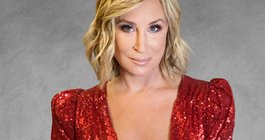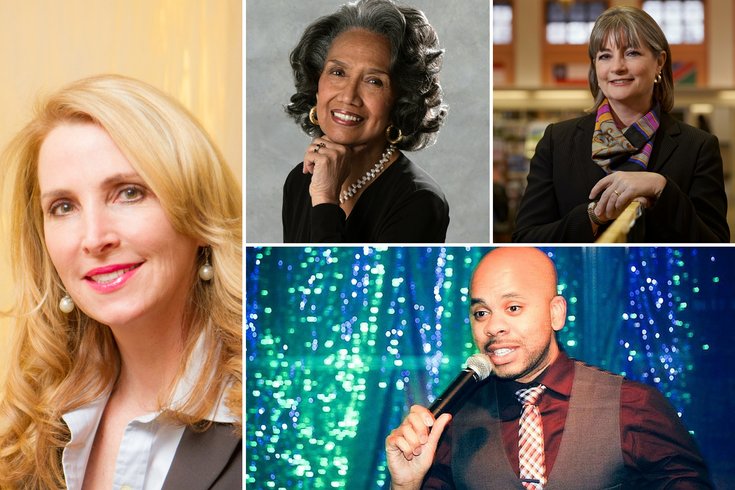
February 04, 2016
 Photo Illustration/Handout Art
Photo Illustration/Handout Art
From left to right, going clockwise, Karin Copeland, Joan Myers Brown, Siobhan Reardon and R. Eric Thomas.
In light of our conversation with newly appointed Chief Cultural Officer Kelly Lee, it was worth asking: What do leaders in Philadelphia's arts & culture community think the city still needs to move forward? And, beyond that, what can the city do to help?
Below, we pose this question to eight leaders from some of the city's most influential institutions, from the Free Library to Philadanco.
"It would be great for Philadelphia to have an individual artist’s bill of rights, giving them much-need support in many areas such as advice about health care, living and work space, job opportunities and access to Philadelphia’s many galleries. The good news is that artists are moving to Philadelphia, but we need to retain and support them.
Philadelphia has several opportunities to help the creative economy here. The city needs to protect and grow the Philadelphia Cultural Fund. We have a large number of extraordinary nonprofits in Philadelphia, many of which rely on this funding stream. The Cultural Fund cannot be viewed as precarious; it needs to be a stable stream of support. In addition, many cities around the country have departments of cultural affairs that provide marketing support, technical advice for nonprofits and information and advice about funding opportunities, as well as opportunities for travel, exhibitions, etc. The departments are resource centers for individual artists and nonprofits, which might be an interesting model for us to try. We want a robust Office of Arts and Culture to continue to operate, and to grow over time serving the artists and nonprofits in our community."
"The city of Philadelphia has always been an incubator for 'artists of color.' But the constant need for them to flee to other cities and countries to garner success continues. Although they seem like catch words, 'limited access, inequity in funding, minimal opportunities and exposure,' etc., they are an inherent part of the American racial divide.
However, that has not ever stopped the flow of talent from the African-American community that comes from this city. Years and years of successful artists moving into the mainstream -- be it music, theater or dance -- is long. (Lee Daniels, Kevin Hart, Patti LaBelle, etc.) Other cities are developing initiatives in support of artists in their community, the most recent in Chicago, or properties being turned over to artists, like in Denver and Dallas. Dedicated taxes and reaching into the neighborhoods and supporting the constant work being done there by the artists themselves, not the so-called well-funded 'outreach programs' by the bigger institutions."
"Art-Reach partners with nearly 200 cultural organizations across the region, so we get to see the depth and breadth of Philadelphia’s arts and culture from the front row. We believe the cultural opportunities in this area are second to none in the country. Cultural organizations in the city are doing so much to invest in their local communities, increase engagement, and tackle some of the most pressing issues facing the region: education, poverty, violence, homelessness, accessibility – the list goes on and on. And yet, despite the magnitude of these challenges, cultural organizations press on forever embracing their missions, and finding ways to engage people in innovative and exciting ways through the arts. We respond to issues and meet challenges head-on to make our communities better for the people of this city.
Despite the programmatic success of arts and culture, the sector continues to deal with decreased funding streams and increased complexity when it comes to networks of underserved individuals in the city. The Office of Arts, Culture and the Creative Economy could aid the sector in peeling back the layers of complexity, and providing more avenues for partnerships, collaborations and engagement with larger public entities (DHS, the school district, etc.). Over the last two years, Art-Reach found out firsthand the complexity of the statewide Access/EBT Card program, and in launching ACCESS Admission, had to hire two separate consultants to aid in the planning effort. Fast-forward 16 months and nearly 60,000 people have benefited from the program. If the office can help the sector navigate these cumbersome partnerships that have a high potential for impact on a city level, we can begin to harmonize need and opportunity, and increase arts engagement across the region. And of course, if that doesn’t work, they can keep advocating for more arts funding overall."
"In order to thrive more fully, I believe the arts and culture community needs greater collaboration. For decades, organizations operated in silos, each focusing on their own goals, markets and fundraising. However, over the past few years, we’ve started to see an incredible shift as organizations have begun joining together and pulling resources, funding, and creative capital to create huge impacts on the city. Here at the Free Library, we rely on these types of collaborations with flagship programs like One Book, One Philadelphia, which over its 14 years has seen hundreds of community partners come together to host interesting and diverse programs focused around one single book ...
When we join forces like this, we can reach wider audiences, create new experiences for our customers, and make a positive collective impact on Philadelphia’s cultural scene. I also serve as chair of The Parkway Council, a collaborative of cultural institutions with a connection to the Benjamin Franklin Parkway. Through the Council we work together to define collaborative activities on the Parkway, join forces to engage the city’s administration as well as commonwealth-elected officials on issues and opportunities affecting the Parkway, as well as act as a conduit to engage the local civic organizations that make the Parkway area their home."
"We know from research that culture and creativity bring dollars, jobs, and workforce innovation to the region, yet local arts groups receive only 2 percent of their revenues from the businesses community. Together with the City, we can do more to encourage the type of engagement — leadership development, employee engagement, grant making and pro bono work— that creates shared value for everyone.”
"Philadelphia’s arts and culture ecosystem is one of the best in the US (maybe the world?) for a lot of things. But if there’s one glaring piece missing to a thriving, sustainable arts ecosystem, it’s art buyers. This is a great city for making art, but if you’re looking to sell it, you’ve got an uphill climb.
At Indy Hall, we’ve been experimenting with new ways to create and share art experiences in a community that results in more people actually buying the art. Not out of a sense of debt or patronage, but because they feel a connection with the art or the artist.
We’ve realized that the creative and technology community is ripe to learn how awesome it is to own local, original art. If you run or work for a startup or small creative/tech business, think about putting local art on your walls.”
"From the perspective of the individual creators on the arts and culture scene, Philadelphia has always been a city of rich, innovative, improvisational music-making, with our artists continually building on tradition to weave a matrix that propels more creation from successive generations. What has been missing in the past have been collective partnerships between artistic disciplines that would reflect the gorgeous mosaic of the lives lived in this metro area. Luckily, the Kimmel Center has been an effective catalyst along these lines, but there should be more collaboration from other arts organizations.
Mayor Nutter, always inspiring with his interest and love for the historic jazz this city has produced, rejuvenated the jazz community in many ways. So I hope the new Chief Cultural Officer Kelly Lee and Mayor Kenney will continue building on his initiatives to include even more opportunities for jazz and blues musicians and singers in Philadelphia to create and participate in the cultural wealth of our extraordinary city."
"I think we're in a wonderful surplus movement in arts and culture where every night of the week you can find vibrant, diverse offerings in the comedy world, LGBTQ-related arts and the theater community ...
It's our responsibility to raise the bar, to keep challenging ourselves and our audiences artistically and structurally. As our spaces improve, our organizations -- both producing venues and creative non-profits -- need to improve the resources allotted to training, innovation and compensation. A lot of this is on the shoulders of the producing entities, who often have to make tough budgetary choices, which sometimes undercut quality or scope of work. The city can help monetarily, yes, but perhaps more importantly, the city can help amplify the work happening in Philadelphia. Marketing takes up a huge amount of time and resources for every artist and organization I know of, myself included. Highlighting -- be it through tourism campaigns or other means, like the great One Book program-- the phenomenal stand-ups, vocal artists and yes, intersectional comedic playwrights working every day can work wonders.